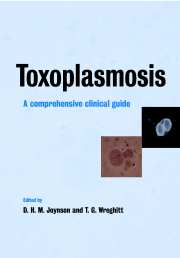Book contents
- Frontmatter
- Contents
- List of contributors
- Preface
- Historical perspective
- 1 Biology of toxoplasmosis
- 2 Immunology of toxoplasma infection
- 3 The epidemiology of toxoplasma infection
- 4 Infection in the immunocompetent
- 5 Toxoplasma infection in HIV-infected patients
- 6 Toxoplasma infection in immunosuppressed (HIV-negative) patients
- 7 Maternal and foetal infection
- 8 Prenatal screening for toxoplasma infection
- 9 Newborn screening for congenital toxoplasma infection
- 10 Infections in neonates and infants
- 11 Ocular infection
- 12 Laboratory diagnosis of toxoplasma infection
- 13 Antitoxoplasma chemotherapy
- 14 Toxoplasma vaccines
- Appendices: protocols for treatment and management
- 1 Suggested treatment protocols
- 2 Management of toxoplasma infection in pregnancy
- 3 Hygiene measures to prevent infection
- 4 Classification system and case definitions of Toxoplasma gondii infection in immunocompetent pregnant women and their congenitally infected offspring
- Index
9 - Newborn screening for congenital toxoplasma infection
Published online by Cambridge University Press: 24 September 2009
- Frontmatter
- Contents
- List of contributors
- Preface
- Historical perspective
- 1 Biology of toxoplasmosis
- 2 Immunology of toxoplasma infection
- 3 The epidemiology of toxoplasma infection
- 4 Infection in the immunocompetent
- 5 Toxoplasma infection in HIV-infected patients
- 6 Toxoplasma infection in immunosuppressed (HIV-negative) patients
- 7 Maternal and foetal infection
- 8 Prenatal screening for toxoplasma infection
- 9 Newborn screening for congenital toxoplasma infection
- 10 Infections in neonates and infants
- 11 Ocular infection
- 12 Laboratory diagnosis of toxoplasma infection
- 13 Antitoxoplasma chemotherapy
- 14 Toxoplasma vaccines
- Appendices: protocols for treatment and management
- 1 Suggested treatment protocols
- 2 Management of toxoplasma infection in pregnancy
- 3 Hygiene measures to prevent infection
- 4 Classification system and case definitions of Toxoplasma gondii infection in immunocompetent pregnant women and their congenitally infected offspring
- Index
Summary
Introduction
Congenital transmission of Toxoplasma gondii, accompanied by severe pathology, was recognized over a half century ago (Wolf et al. 1939). Medical communities around the world have struggled with how best to respond to this threat. Even though an impressive amount of knowledge of T. gondii has been accumulated, some of the most basic questions required to set public health policies regarding congenital toxoplasmosis have yet to be answered.
In the midst of such uncertainty, and under influences unique to each region of the globe, three philosophical approaches to the detection of congenitally infected babies have evolved:
universal prenatal screening of mothers to identify those who seroconvert to produce T. gondii antibody during pregnancy;
universal newborn screening to identify infants with T. gondii specific IgM; and
no universal programme.
It is doubtful that any one of these may presently be unequivocally deemed the approach of choice for all communities.
In 1986, The New England Newborn Screening Programme, currently operating under the University of Massachusetts Medical School, was the first centre to choose the second option, newborn screening, on a universal scale. In January 1999, countrywide newborn screening was implemented in Denmark. Newborn screening for congenital toxoplasmosis is also being performed in parts of Brazil and France (Marseilles region), and pilot programmes have been initiated in other countries.
- Type
- Chapter
- Information
- ToxoplasmosisA Comprehensive Clinical Guide, pp. 241 - 253Publisher: Cambridge University PressPrint publication year: 2001

